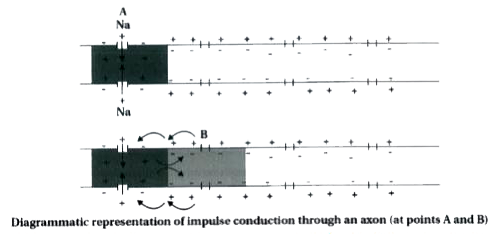What is resting potential ? How is conduction of nerve impulse takes place ?
Text Solution
Neurons are excitable cells because their membranes are in a polarised state.
Different types of ion channels are present on the neural membrane. These ion channels are selectively permeable to different ions.
When a neuron is not conducting any impulse, i.e., resting, the axonal membrane is comparatively more permeable to K+ and nearly impermeable to Na+. Similarly, the membrane is impermeable to -vely charged proteins present in the axoplasm.
The axoplasm inside the axon contains high concentration of K+ and -vely charged proteins and low concentration of Na+. In contrast, outside the axon K+ low concentration and high concentration of Na+ forms a concentration gradient.
These ionic gradients across the resting membrane are maintained by transport of 3Na+ outwards and 2K+ inside the cell.
As a result, the outer surface of the axonal membrane is +vely charged and its inner surface becomes -vely charged and therefore it is polarised.
The electrical potential difference across the resting membrane is called the resting potential.
When a stimulus is applied at point A on the polarised membrane, it becomes freely permeable to Na+,Na+ influx is followed by the reversal of the polarity, i.e. outer membrane is -vely charged and inner side is +vely charged.
The polarity at the site A is reversed and hence depolarised. The electrical potential difference across the plasma membrane at the site A is called action potential which is infact termed as nerve impulse.
At sites immediately ahead, the axon membrane has +ve charge on the outer surface and a −ve charge on its inner surface. As a result, a current flows on the inner surface from site A to site B. On the outer surface current flows from site B to site A to complete the circuit of current flow. Hence, the polarity at the site is reversed and an action potential is generated at the site B.
Thus, impulse (action potential) generated at site A arrives at site B.
The sequence is repeated along the length of the axon and consequently the impulse is conducted.
The rise in the stimulus induced permeability to Na+ is short lived. It is quickly followed by the rise in permeability to K. Within a fraction of a second, K+ diffuses outside and restores the resting potential of the membrane.

Diagrammatic representation of impulse conduction through an axon (at points A and B)
|
Updated on:21/07/2023
Topper's Solved these Questions
- BOOK - KUMAR PRAKASHANCHAPTER - NEURAL CONTROL AND COORDINATIONEXERCISE - SECTION - B (DIFFERENCE/SCIENTIFIC REASONS)11videos
NEURAL CONTROL AND COORDINATION
- BOOK - KUMAR PRAKASHANCHAPTER - NEURAL CONTROL AND COORDINATIONEXERCISE - SECTION - C (DEFINITION/EXPLANATION - TERMS/IMPORTANCE)21videos
NEURAL CONTROL AND COORDINATION
- BOOK - KUMAR PRAKASHANCHAPTER - MORPHOLOGY OF FLOWERING PLANTSEXERCISE - questions from module -(Important MCQ for NEET)4videos
MORPHOLOGY OF FLOWERING PLANTS
- BOOK - KUMAR PRAKASHANCHAPTER - PHOTOSYNTHESIS IN HIGHER PLANTSEXERCISE - FILL IN BLANKS10videos
PHOTOSYNTHESIS IN HIGHER PLANTS
Similar Questions
Knowledge Check
- Question 1 - Select One
Conduction of nerve impulse is a
AChemical processBPhysical processCElectrochemical processDBiochemical process - Question 2 - Select One
During conduction of nerve impulse
ANa+ moves out of axoplasmBNa+ moves into axoplasmCK+ moves into axoplasmDCa2+ moves into axoplasm - Question 3 - Select One
Conduction of nerve impulse depends upon
AMyelin sheathBTemperatureCDiameter of nerve fibreDAll of these

